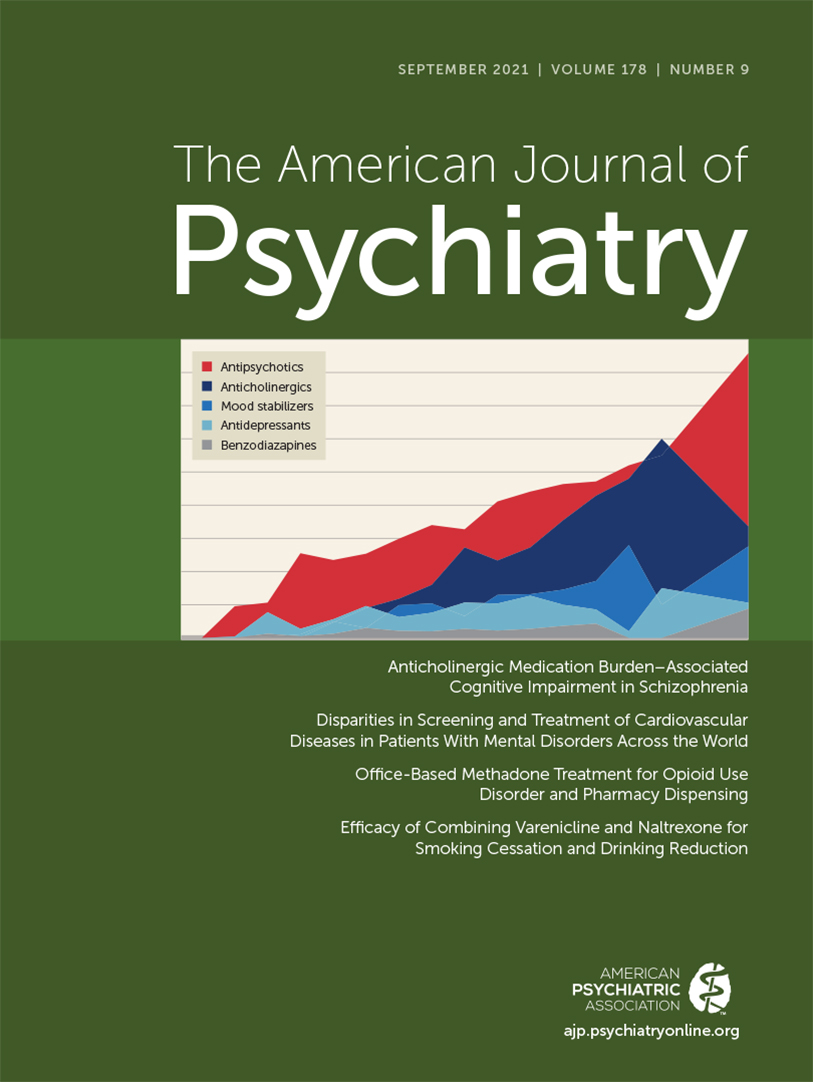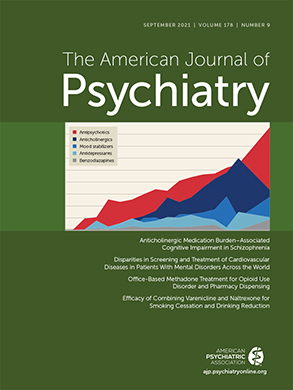Despite decades of research, what we don’t know about remission and recovery from anorexia nervosa could fill libraries. In this issue, Walsh et al. (
1) reach back into their clinical trial data archives (
2) to address the critical question of whether a post-weight-restoration inflection point can be identified that would support a declaration of recovery from anorexia nervosa in adult patients. The short answer to that research question is, “No,” and in fact, the window of greatest risk for “relapse” is the ∼60-day period after discharge from inpatient or day program treatment, followed by a gradual reduction in relapse risk over the following year. This fairly straightforward secondary analysis of a clinical trial conducted in the early 2000s raises several critical clinical and research issues and highlights how far we haven’t come in treating this far too frequently deadly illness.
A gaping omission in the eating disorders field is consensus definitions of remission, relapse, and recovery in anorexia nervosa (
3). In fact, we are not even clear on whether we should consider anorexia nervosa to be episodic, remitting and relapsing, or, if once afflicted, one remains at elevated risk of reoccurrence throughout life. The results of the initial clinical trial on which these analyses were based, which showed no impact of fluoxetine on time to relapse, coupled with the fact that no medications have risen to the designation of a U.S. Food and Drug Administration indication for the treatment of anorexia nervosa, underscore how poorly equipped clinicians are to facilitate recovery with primary or adjunctive pharmacological interventions. Sadly, this paragraph could have been written 20 years ago. We’re treading water as a field when it comes to the treatment of anorexia nervosa, especially in adults.
The key observation from this reanalysis has direct policy, guideline, and carer implications. Specifically, the 60-plus-day window after discharge from acute weight-restoration treatment marks a critical window when relapse risk for anorexia nervosa is at its highest. Thereafter, relapse risk gradually declines, with no obvious point of rarity or amount of time after which an individual could be considered to be recovered and thereafter unlikely to experience a return of the illness (
4). An important note for patients and caregivers is that this does not mean that recovery isn’t possible. It means that relapse becomes increasingly unlikely with time—although, importantly, the observation period was only 1 year after treatment completion. Vigilance must continue thereafter to ensure that lapses don’t descend into relapses. We have postulated that care must be taken to avoid the trap of negative energy balance (i.e., expending more energy than one consumes), possibly forever, as this, at least anecdotally, can precipitate anorexia nervosa relapse (
5).
Critically, weight restoration (indexed by a BMI of 19 in this study) is in no way an adequate definition of remission. First, weight restoration is only one treatment goal. Second, a BMI of 19 represents a “minimally normal weight” (
6) for individuals undergoing weight restoration treatment for anorexia nervosa, and hospital discharge at that point is in no small part due to the cost to third-party payers of inpatient or residential weight restoration treatment (
7). Hospital discharge decisions should consider not only weight gain, but also cognitive, affective, and behavioral aspects of the illness, and care should be taken to ensure a seamless transition to lower levels of care. If step-downs are not immediately available, digital bridges can aid in ensuring continuity of care (
8–
11).
How can we use information from this study to improve outcomes? We can quote these data loudly and often when faced with premature hospital discharge, discontinuation, or step-down whether due to insurance denials or patient choice. We can arm ourselves with these data to advocate for our patients. We can quote these data to underscore the critical importance of better research on optimal implementation of step-down care models. A fully integrated step-down model would incorporate several levels of care: inpatient renourishment, residential treatment program, day program/partial hospitalization, intensive outpatient treatment, and outpatient treatment. Novel additions such as home-based care (
12), virtual care (
13), self-admission (
14,
15), and digital adjuncts (
8) could augment traditional levels of care and reduce the chances of returning to a higher level of care just weeks after returning home.
However, as highlighted in a recent opinion article (
16), appropriately paced stepped care is rarely achievable in the United States. Patients and families scramble to find appropriate step-down options, often crisscrossing institutions and even states to access services, leading to rifts in continuity of care. A hypothetical treatment trajectory of acute inpatient treatment in Denver, followed by residential treatment in Philadelphia, then back to outpatient care at home in Arkansas is disruptive, might mix and match a grab-bag of evidence-based and idiosyncratic care, does a disservice to carers who may be differentially involved across sites, and is enormously costly for patients and families. Imagine if this geographical pattern were necessary for the treatment of asthma or type 1 diabetes. Imagine again the number of people with anorexia nervosa whose families could never pay for this patchwork treatment, or who have to take out a second mortgage on their house, or quit their job to accompany their young adult offspring to live in another city to access partial hospitalization or residential care. The burden that our broken system puts on patients and families is incalculable emotionally, and financially amounts to ∼$64.7 billion annually, equating to $11,808 per person with an eating disorder (
17).
To be sure, the field has advanced in other ways, but those advances have not yet translated into improved treatments. For example, much of the recent work conducted on the genetics of anorexia nervosa suggests that we may need to focus our interventions not only on the psychiatric but also on metabolic factors that underlie the illness (
18). Often, we have viewed the posthospitalization loss of therapeutically restored weight as a willful return to the underweight state, driven by the characteristic psychopathology (drive for thinness, body dissatisfaction) of anorexia nervosa. That may capture only part of the story. What if, as the genetic findings urge us to consider, the rapid reloss of restored weight represents more of a metabolic phenomenon, with the psychological overlay being more epiphenomenal? Discharging a patient from inpatient care when they reach 85% of their ideal body weight (which is not uncommon) may not only put them at risk of immediate relapse psychologically, but may also put them at risk metabolically. Achieving a healthy weight (i.e., more than a minimally normal BMI) and maintaining it over a sustained period of time may be essential to give the metabolism (and the brain) the opportunity to re-equilibrate without the metabolic pull back down to the previously attained low weight settling point (
19).
This data revisit screams at us to ensure that our postdischarge treatment plans are intensive and that the transition to outpatient care is gradual. The step from 24/7 care to weekly psychotherapy is perilously steep. Patients, parents, and caregivers should be well-informed of the high risk of relapse in the months after discharge, and step-down interventions must be crafted and offered that closely monitor weight and energy intake, with immediate step-back-up when downward trends emerge. The authors point out that weight maintenance is only one marker of recovery, and that is indeed true. However, full psychological, behavioral, and physical recovery from anorexia nervosa cannot occur in its absence.
Repeat hospitalizations are demoralizing, life-interrupting, and financially and emotionally exhausting for patients, carers, and providers. Carers should be educated and empowered to evaluate and demand comprehensive discharge plans and insurance coverage that buttress patients against posthospitalization relapse. Telehealth support should persist after the COVID-19 pandemic to allow continuity of care, even if patients are discharged home to another state. Novel digital relapse programs should be developed and tested. The transition to value-based care cannot come soon enough for patients with anorexia nervosa (
20). Easing of licensure laws to allow cross-state practice would ensure that individuals with anorexia nervosa who come from states and regions that lack specialty care can still access evidence-based interventions. Moreover, we have to do a better job at early detection and intervention to prevent the initial descent to low weight that is a harbinger of poor outcome (
21).
We need to pull out all stops to halt the revolving door.
Perhaps the most demoralizing passage in the Walsh et al. paper is, “Finally, it might be argued that, since this study was initiated over 20 years ago, it employed a now-outdated psychological treatment (CBT); unfortunately, no clearly superior treatment methods have since been identified.” We had 20 years to develop superior treatment methods and still have not come through for our patients and families. As providers and researchers, we have to up our game, and the National Institutes of Health and other funding bodies around the world have to support us in developing and testing pharmacologic and behavioral interventions that provide more hope for patients and carers and that reduce or eliminate the shamefully high mortality associated with anorexia nervosa.

